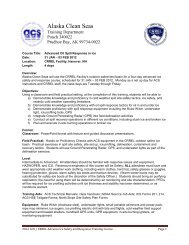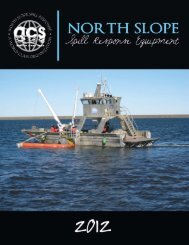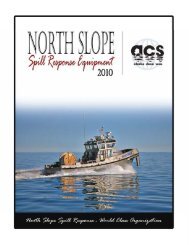- Page 1 and 2: Alaska Clean Seas Technical ManualV
- Page 3 and 4: ! !!!!!!!!!!!!!!!!!!!!!!!!!!!!!!!!!
- Page 5 and 6: TACTICTACTICNOTE: “Base Location
- Page 7 and 8: SAMPLE TACTICS DESCRIPTIONTactics a
- Page 9 and 10: AcronymsAcronymsACACSADECADF&GADNRA
- Page 11 and 12: TACTICS LIST (Page 3 of 4)(Page 4 o
- Page 13 and 14: TACTIC S-1 Site Entry Procedures (P
- Page 15 and 16: TACTIC S-3 Identifying Required Per
- Page 17 and 18: TACTIC S-4 Site Layout (Page 1 of 2
- Page 19 and 20: TACTIC S-6 Decontamination (Page 1
- Page 21 and 22: TACTIC S-6 Decontamination (Page 5
- Page 23 and 24: TACTIC S-6 Decontamination (Page 9
- Page 25 and 26: TACTIC S-8 Safety During Operations
- Page 27 and 28: TACTIC C-2 Deflection Booming at a
- Page 29 and 30: TACTIC C-4 Barriers on Land (Page 1
- Page 31 and 32: TACTIC C-6 Underflow Dam (Page 1 of
- Page 33 and 34: TACTIC C-8 Deflection Booming in St
- Page 35 and 36: TACTIC C-8 Deflection Booming in St
- Page 37 and 38: TACTIC C-10 Containment Using Ice R
- Page 39: TACTIC C-12 Trenching Ice to Direct
- Page 43 and 44: TACTIC C-16 Anchored W Deflection B
- Page 45 and 46: TACTIC C-18 Containing Light Layer
- Page 47 and 48: TACTIC R-1 Mechanical Recovery of L
- Page 49 and 50: TACTIC R-2 Manual Recovery of LIght
- Page 51 and 52: TACTIC R-4 Flushing of Oil on Tundr
- Page 53 and 54: TACTIC R-6 Recovery by Direct Sucti
- Page 55 and 56: TACTIC R-8 Use of Portable Skimmers
- Page 57 and 58: TACTIC R-10 Fairchild Gate Weir Col
- Page 59 and 60: TACTIC R-12 Aggressive Breakup in R
- Page 61 and 62: TACTIC R-14 Recovery of Oil Under I
- Page 63 and 64: TACTIC R-15 Anchored V-Boom to Skim
- Page 65 and 66: TACTIC R-17 J-Boom to Skimmer and M
- Page 67: TACTIC R-19 J-Boom to Tank Barge or
- Page 70 and 71: TACTIC R-21 Hot-Water, High-Pressur
- Page 72 and 73: TACTIC R-23 Tank on Trailer (Fuel T
- Page 74 and 75: TACTIC R-25 Freighter Boat with Tan
- Page 76 and 77: TACTIC R-27 Damaged Tank Transfer P
- Page 78 and 79: TACTIC R-29 Ice Mining (Page 1 of 2
- Page 80 and 81: TACTIC R-31 Free Skimming (Page 1 o
- Page 82 and 83: TACTIC R-32B Double Boom-Arm Skimmi
- Page 84 and 85: TACTIC T-1 Delineation of Oiled Sno
- Page 86 and 87: TACTIC T-3 Detection and Delineatio
- Page 88 and 89: TACTIC T-4A Discharge Tracking in I
- Page 90 and 91:
TACTIC T-6 Blowout Modeling (Page 1
- Page 92 and 93:
TACTIC T-6 Blowout Modeling (Page 5
- Page 94 and 95:
TACTIC T-7 Spill Volume Estimation
- Page 96 and 97:
Safe Distance in Populated, Flat Te
- Page 98 and 99:
TACTIC B-1A In-Situ Burning Plan an
- Page 100 and 101:
TACTIC B-3 In-Situ Burning with Hel
- Page 102 and 103:
TACTIC B-4 Deployment and Use of Fi
- Page 104 and 105:
TACTIC B-6 Burn Residue Recovery (P
- Page 106 and 107:
TACTIC DT-1 Dispersant Application
- Page 108 and 109:
TACTIC DT-3 Dispersant Application
- Page 110 and 111:
TACTIC SH-2 Natural Recovery of an
- Page 112 and 113:
TACTIC SH-4 Shoreline Cleanup Using
- Page 114 and 115:
TACTIC SH-6 Shoreline Cleanup Using
- Page 116 and 117:
TACTIC SH-8 Shoreline Cleanup Using
- Page 118 and 119:
TACTIC SH-10 Shoreline Cleanup Usin
- Page 120 and 121:
TACTIC SH-12 Summary of Potential I
- Page 122 and 123:
TACTIC W-1A RRT Hazing Checklist (P
- Page 124 and 125:
TACTIC W-1A RRT Hazing Checklist (P
- Page 126 and 127:
TACTIC W-1B RRT Capture/Transportat
- Page 128 and 129:
TACTIC W-1B RRT Capture/Transportat
- Page 130 and 131:
TACTIC W-1B RRT Capture/Transportat
- Page 132 and 133:
TACTIC W-2 Wildlife Hazing Equipmen
- Page 134 and 135:
TACTIC W-2B Bird Hazing (Page 1 of
- Page 136 and 137:
TACTIC W-4 Salvage of Dead Wildlife
- Page 138 and 139:
TACTIC W-6 Identifying and Protecti
- Page 140 and 141:
LIQUID WASTETACTIC D-1 Processing R
- Page 142 and 143:
TACTIC D-1 Processing Recovered Liq
- Page 144 and 145:
TACTIC D-2 Storage and Disposal of
- Page 146 and 147:
TACTIC D-3 Disposal of Non-Oily Was
- Page 148 and 149:
TACTIC D-4 Stockpiling Oiled Gravel
- Page 150 and 151:
TACTIC L-1 Ice Road Construction fo
- Page 152 and 153:
TACTIC L-2 Staging Areas (Page 3 of
- Page 154 and 155:
TACTIC L-3 Deployment Strategies (P
- Page 156 and 157:
TACTIC L-4 Logistical Support (Page
- Page 158 and 159:
TACTIC L-5 Communications (Page 3 o
- Page 160 and 161:
TACTIC L-5 Communications (Page 7 o
- Page 162 and 163:
TACTIC L-6 ACS Response Equipment S
- Page 164 and 165:
TACTIC L-6 ACS Response Equipment S
- Page 166 and 167:
TACTIC L-7 Realistic Maximum Operat
- Page 168 and 169:
TACTIC L-7 Realistic Maximum Operat
- Page 170 and 171:
TACTIC L-7 Realistic Maximum Operat
- Page 172 and 173:
TACTIC L-9 Accessing Contract Resou
- Page 174 and 175:
TACTIC L-11 Best Available Technolo
- Page 176 and 177:
TACTIC L-11A BAT Analysis: ACS Comm
- Page 178 and 179:
TACTIC L-11C BAT Analysis: Wildlife
- Page 180 and 181:
TACTIC A-1 Emergency Action Checkli
- Page 182 and 183:
TACTIC A-2 Spill Reporting Procedur
- Page 184 and 185:
TACTIC A-4 Training Requirements fo
- Page 186:
TACTIC A-5 ACS Certifications (Page






